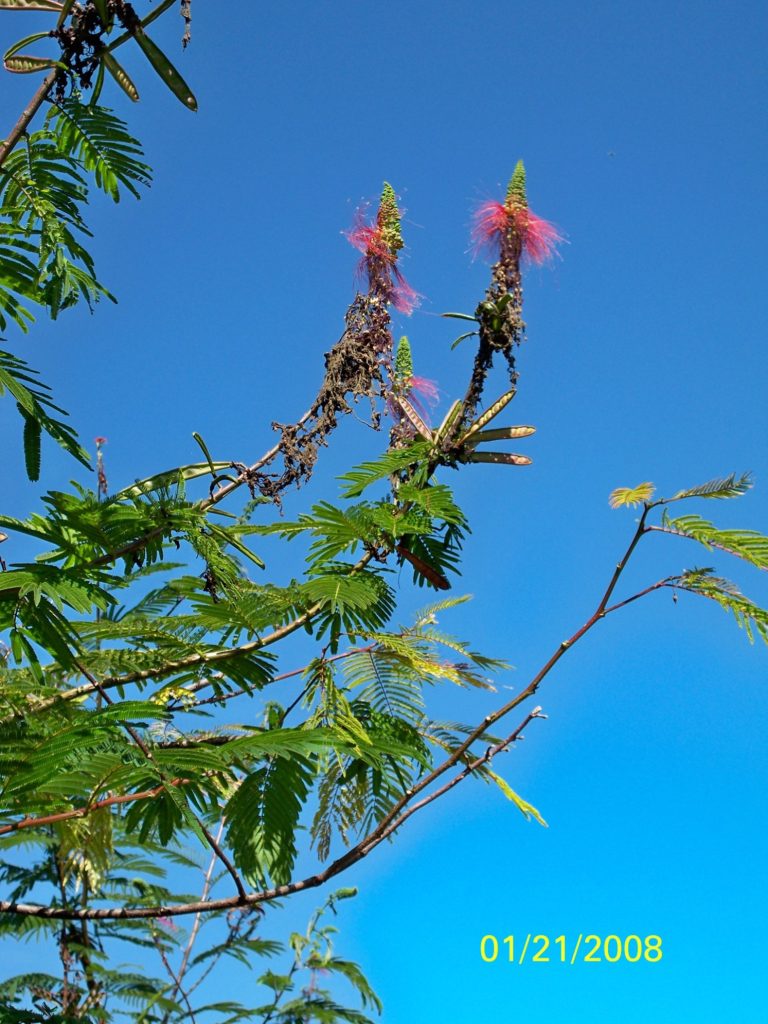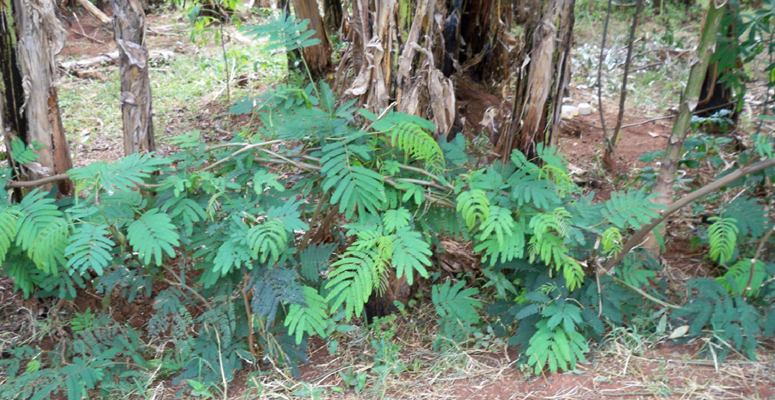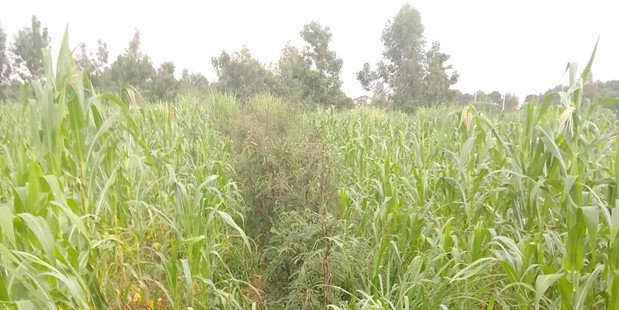Agroforestry: Intercropping with trees on farms and pastures – with a focus on the subhumid tropics
Figure 1 (Used as cover picture). Hedge of the nitrogen-fixing Calliandra calothyrsus successfully direct seeded with improved low-cost methods and used for fodder and fuel in a Nitrogen-deficient maize field in sub-humid Kenya. Photo: Philip Amimo 2023.
Agroforestry – intercropping with trees.
This practice is usually a way of farming where trees and other crops -and sometimes animals- are raised together (intercropped). It benefits people and the environment and is profitable – if done correctly. Many forms exist. In the tropics, there are many different ways to do agroforestry. Some common agroforestry strategies are: -growing trees with crops, -having animals graze partly under trees (silvo-pastoralism), or -growing fruit trees, nuts, and other crops in diverse forest gardens. Fields with an important number of trees, shrubs, and/or hedges can be called agroforestry. Figure 1.
Unfortunately, most “agroforestry” or “forest garden” terms raise the expectation of a forest-like system – or believe that enough trees will make a moist forest or return to a garden of Eden.
It does not have to look like a forest, but it can sometimes be a valuable stage to establish, manure, and weed young forests or plantations (taungya system) and protect it from fires.
Trees may be around field boundaries, buildings, roads, or contour lines or scattered like in parkland agroforestry. Agroforestry can help improve soil, fight climate change, and provide food and money for people. But sometimes it is hard to do because of bad rules or people not knowing about it. If we do more research and better manage agroforestry, it can help protect the environment and ensure we have enough food.
Agroforestry – important in the subhumid tropics
Agroforestry is found in all cultivated climate zones. It is particularly important in the subhumid tropics.
Unlike the semi-arid areas, they have excess seasonal rainwater that deep-rooted trees can use that else would be lost. Also, deep roots and trees are needed for dry seasons fodder in the sub-humid tropics. Likewise, permanent plants are needed for soil and water conservation at the start of the rainy season.
Better agroforestry learning is needed
Agroforestry can be good or bad for soil conservation. It is good if it adds value and surface cover e.g., contour stripes with undergrowth and plant residues. On the other hand, it is bad if small raindrops join and accelerate to fall with more erosive force per square meter on the bare ground below them. It has been documented in research for decades, but few are aware. See Mandal’s articles at WikiFarmer Library, e.g.[i] [1].
Agroforestry guidelines for the tropics are often based on old guidelines and what people already think they know -e.g., about tree establishment. Solutions to key problems are introduced in this and other articles by Mandal on agroforestry.
Challenges: Costs and competition in an agroforestry system
In order for more farmers to use agroforestry, it is necessary to reduce the cost of establishing trees (incl. work and risk), and early benefits are increased, and farmers have access to suitable, relevant knowledge. This way, products that can be sold early will be produced. [2] [ii]
Trees can often reduce the yield of crops grown together with them. Maize grown in the shade of Cordia, Croton, and Acacia trees produced much less than in open fields in subhumid and semi-arid Ethiopia. The reduction was lower for the tree legume species group (genera). Acacia is from the mimosa part (with hairy flowers) of the bean or pea (=legume. Fabaceae) family and can fix and use nitrogen from soil air like those with bean-like flowers. More money from trees meant less money from maize. But, using suitable farming methods like planting early, using the right type of maize, controlling weeds, preparing the soil well, and using more nitrogen fertilizer can help reduce the loss of maize grown near trees. [3] [iii]
Trees compete with (other) crops in many ways, but they also partly differ in their needs and can benefit crops as well. The effect of trees on crops can be hard to know from observation of existing farmer’s fields. Most trees are sometimes found in the most fertile places where forest-enriched soil or waste from homesteads did. However, the most fertile land may also be selected first for crops, and the less fertile left with many trees to save costs or improve the soil. Likewise, areas differ in access to water and nutrients, the effect of shade, etc. Places near the homestead will get the most recycled nutrients, and erosion will remove nutrients to places with the sedimentation of topsoil – e.g., hedges with the covered soil surface.
Alley cropping – Strip Cropping: Tree rows or trimmed hedges between crops
Alley cropping is an agroforestry practice that involves growing an arable crop between rows of trees or perennial shrubs. In tropical alley cropping, the perennial species, usually leguminous trees or shrubs, are planted and managed as hedgerows, usually less than 10 m apart, with the crop planted in the interspaces or alleys between the hedgerows.
The hedges can provide nutrient recycling and soil-erosion control comparable to those in the fallow phase of shifting cultivation. The choice of tree species is important, e.g., tolerance to acidic soil low in phosphate, as in the case of Calliandra calothyrsus rather than the earlier most promoted species.
Technically, alley-cropping has performed well in areas with enough rain, so limited adoption by farmers is usually blamed on a lack of administrative support [iv]. [4] Unfortunately, the need is usually neglected for further adapting the techniques and guidelines to small farmers’ need for early benefits at low or no cash cost. This results in waste of seed, seed production, work, and money [1].
Alley cropping is sometimes also used for timber or not trees established and/or grown between crops or pasture plants, e.g., in the USA, with wide distance and no (top) pruning. See the intercropping introduction article by Mandal at Wikifarmer for a reference to a free guideline from the USA.
Fast-growing nitrogen-fixing fodder trees intercropped in humid and subhumid tropics.
A few trees of the legume (Fabaceae) family can sometimes improve the growth of other crops, grow fast, tolerate being cut low, fix nitrogen from the air, and can give fuel to wood and soil and water conservation. For example, Leucaena species, Gliricidia sepium, and Calliandra calothyrsus. Sesbania species do not tolerate cutting all leaves, but Mandal found that young stems can be twisted together, and new vertical shoots cut. “Calliandra” is a small, thornless, often multi-stemmed shrub that can be used in alley cropping systems [v]. [5] In alley-cropping systems, C. calothyrsus is an important Calliandra species for agroforestry. It is usually recommended to prune (cut back) in cycles or up to 4 months to limit shade on associated crops[vi]. [6] Mandal developed management alternatives; see below and Figures 1,2 and 3.
Agroforestry and hedges for multipurpose soil- and water conservation can be effective, but the importance of cover near the surface is often neglected even in guidelines and test sites. [1] Frequently weeded demonstration hedges cannot affect erosion (World Agroforestry / ICRAF compound, Nairobi), while the effect was strong in farmer-established, direct-seeded hedges near Maseno in Kenya (Mandal’s observations 2019). Tree legumes can also be intercropped with fodder grass lines and supply nitrogen and dry season feed. The tree legumes should get time to be established first.

Figure 2. Calliandra calothyrsus (called Calliandra) in the dry season in western Kenya. The lower branch is trimmed with a forked branch. Photo: Torsten Mandal.
Fodder shrubs: The example of Calliandra calothyrsus (Spiked Powder Puff)
Calliandra calothyrsus is becoming particularly popular with its fast-growing green parts. They can be used in agroforestry systems to restore fallow land and, at the same time, produce fuel wood or fodder on farms and also increase the yield of food crops. However, one study found that Calliandra reduced soil evaporation directly from the soil. Still, the water saved was absorbed by its extensive root system, depriving crops of enough water, so crop yields were reduced despite some pruning. [7] Often, Calliandra is pruned too little and too late by researchers based on needs from other tree legumes it is compared with. For fodder, mixtures of different tree legumes and other plants are best.
A recent study from Uganda confirms many other neglected studies. The researchers found that only one-third of farmers started using fodder shrubs, even though two-thirds knew about them. This was because it was hard to get the plants and they did not know how to use them.
Fodder shrubs do not need much work to keep them growing, but it takes a lot of time and money to start growing them (with the usual guidelines). This can be hard for small farmers who have little money and are afraid to take risks. So, even though fodder shrubs can be good for farmers, it has been hard to get them to start using them [8].
A helpful field guideline for the management of calliandra was published in Wambugu (2002). [9] However, it has no references to documentation, and Mandal has some suggestions for improvement.
For example, using wood ash as a nutrient source, calliandra is recommended in line with the studies by Mandal and Nielsen (e.g. 2004)
However, if mixing much ash (that is alkaline) with manure, it is best to do it shortly before mixing it into the soil or mixing ash directly into the soil to avoid it causing loss of ammonium (NH4+) Nitrogen as Ammonia (NH3) gas to the air from throwing ash at the top of the manure. Mixing 1-3% ash well into manure will not increase pH much. Ash may be enough for N-fixing trees.
Mandal explains [10, 11] also that cutting does not always have to be done to limit competition. When it suits the farmer, new alternatives to cutting are stripping the stems with a forked branch, bending and twisting them together, and/or breaking them partly over a knee. See Figure 3.
These methods to manage tree legumes makes it possible to intercrop at least the typical fast-growing tree legumes (incl. some Albizia species) without e.g., shading surrounding crops much in the cropping season like if the trees were cut low twice in the rainy season. That is also important for water and nutrient competition. However, wood, flowers, nectar, seed, and foliage can easily be saved by the new methods by Mandal, verified by local farmers in western Kenya. If transplanting “overgrown” seedlings, cutting and keeping side roots 4 cm short, as recommended, can damage their function. Curving roots when transplanting in a planting hole is actually not a problem (despite common beliefs), and drying of roots can be prevented in several ways for local transplantation. [11]

Figure 3. Calliandra calothyrsus hedge that is direct-seeded with improved low-cost methods by a farmer in western Kenya and bent and twisted together and intercropped with banana and cassava. Photo: Torsten Mandal in a dry season.
Tree establishment: A key challenge in an agroforestry system
The time between tree establishment efforts and the benefits of trees is a significant challenge that farmers face when choosing to adopt an agroforestry system. In many countries, e.g., Uganda, farmers have trouble getting high-quality tree seedlings because the places that supply them are far away. This means that most tree seedlings come from small roadside tree nurseries and seed dealers who know little about where to get good seeds or how to grow good seedlings [12]. Financial support today tends to be short-lived. Getting tree seeds to germinate and grow well in rapidly watered, hot plastic bags is hard without access to fibrous materials or even a good combination of clay, sand, and well-composted manure. Damaging, restricting, or breaking roots for transplanting seedlings harms the survival of drought and low-fertility soils.
Alternatively, direct seeding maintains the tap root. Still, it requires germination in time, helps to penetrate a hot sunny surface and compete protection, and occasionally a bit of watering in the field etc. For improved low-input methods mainly to establish tree legumes, see Mandal and Nielsen 2004,[10] and Mandal, e.g., [11, 13, 14]. Bare-root transplanting seedlings is a relatively fast and cheap standard method for forestry and agroforestry in temperate areas. However, without a cold dormant period, it is challenging without being impossible. Various other traditional and innovative other options exist too.
Intercropping causes not only competition. High-forest (climax) and fruit tree species will often be stressed as seedlings in an intense, direct sun combined with heat and drought. Starting with pioneer trees (particularly fast-growing tree legumes) can help, as well as intercropping with scattered banana, maize, or pigeon pea. However, competition for water below the shaded surface is a challenge.
References
1. Mandal T (2022) Agroforestry – combining trees and agriculture to improve Soil – Water Conservation – Wikifarmer
2. Mahmud A A, Raj A, Jhariya M K (2020) Agroforestry systems in the tropics: A critical review. AGBIR; 36(5):83-87
3. Sida, T S and others (2018) “Crop vs. tree: Can agronomic management reduce trade-offs in tree-crop interactions?” Agriculture, Ecosystems & Environment 260: 36-46.
4. Nair P K R, Kumar B M, Nair V D (2021). Tropical Alley Cropping and Improved Fallows. In: An Introduction to Agroforestry. Springer, Cham. https://doi.org/10.1007/978-3-030-75358-0_6 6
5. Agroforestry Database 4.0 (Orwa et al.2009) Calliandra_calothyrsus.PDF (worldagroforestry.org) .
6. Murithi F M (2002). Calliandra calothyrsus: assessing the early stages of adoption of a fodder shrub in the highlands of central Kenya: Trees on the farm: assessing the adoption potential of agroforestry practices in Africa. World Agroforestry Centre.
7. Calliandra calothyrsus. (n.d.). ScienceDirect Topics. #
8. Hughes K, Auma Oduol A B J, Kegode H, Kimaiyo J & Mausch K (2022): Experimental evidence from a fodder shrub promotional effort among dairy farmers in Uganda, Journal of Development Effectiveness, DOI: 10.1080/19439342.2022.2099952
9. Charles Wambugu (2002) Calliandra calothyrsus. Tree management and utilization. A pamphlet for farmers and field extension staff. ICRAF. BR02401.pdf (worldagroforestry.org)
10. Mandal, T, Nielsen, N E (2004). An improved low-input method for establishing calliandra hedgerows on small-scale farms in western Kenya. Agroforestry Systems 60, 227–231 https://doi.org/10.1023/B:AGFO.0000024414.50076.66
12. Odoi, J B, Buyinza, J, Okia C (2019). Tree Seed and Seedling Supply and Distribution System in Uganda. Small-scale Forestry.
13. Mandal T (2011). Seed management: A farmer friendly method. In: Trees and Farming issue of Farming Matters. Illeia. Wageningen. Link: Seed management: A farmer friendly method. Ileia










































































